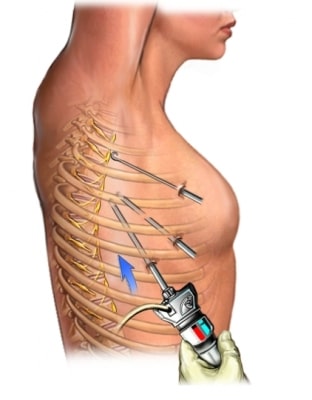Thoracoscopy Tunisia
What is a thoracoscopy?
 A minimal technique called thoracoscopy is used to examine and treat spaces inside the rib cage, including the lungs, pleura, and chest wall. It is carried out using an endoscope, a small instrument equipped with a light source and a tube. Lung diseases, such as lung cancer, are often diagnosed and treated using thoracoscopy.
A minimal technique called thoracoscopy is used to examine and treat spaces inside the rib cage, including the lungs, pleura, and chest wall. It is carried out using an endoscope, a small instrument equipped with a light source and a tube. Lung diseases, such as lung cancer, are often diagnosed and treated using thoracoscopy.
How is thoracoscopy performed for pulmonary diagnosis?
Thoracoscopy is performed under general anesthesia and involves inserting a thoracoscope, a medical instrument equipped with a camera and small surgical instruments, into the chest cavity through small incisions. Doctors can view the inside of the chest using a thoracoscope and examine lung structures. Samples of lung tissue may be taken from areas that appear abnormal to examine. It is possible to inject medications or other treatments directly into the lung. Thoracoscopy is a less invasive procedure than thoracotomy, which may result in faster recovery and less pain.
How is recovery after a thoracoscopy?
Recovery after thoracoscopy depends on the lung disease and the surgical procedure. Thoracoscopy is generally considered a less invasive treatment than thoracotomy, which may result in faster recovery and less pain. The patient is monitored for a few hours in the recovery room after the procedure before returning to their room. Depending on the nature of the lung disease and individual response to treatment, the length of hospitalization may vary from 1 to 4 days. After the procedure, patients may experience chest pain, fatigue, and coughing for several days.
What are the advantages ?
The benefits of thoracoscopy are numerous, including:
You feel less pain after surgery, which reduces the negative impact on your body.
Reduce infectious risks.
Reduce the probability of parietal complications.
Reduction in operating time for certain procedures.
Reduction in the length of hospital stays.
Use a viewing probe (thoracoscope) to visualize the lung surfaces and pleural cavity.
It is possible to obtain a tissue sample for microscopic examination and culture.
Use a thoracoscope to drain fluid accumulations in the pleural cavity.
What are the potential complications ?
Potential complications of thoracoscopy include infections, persistent bleeding, persistent air leaks, collapsed lungs, breathing problems, perforated lungs, and in rare cases, air coming from the chest. thoracic cavity in the tissues under the skin of the chest, neck, and face. It is important to note that although rare, these complications can occur.
How long does a thoracoscopy typically take?
Depending on the complexity of the procedure, the average duration of a thoracoscopy varies. A thoracoscopy can usually take anywhere from thirty minutes to two hours. The duration of hospitalization also varies, ranging from three to four days to more than ten days depending on the case.
What are the expected results ?
The expected outcomes of a thoracoscopy include the ability to perform effective surgeries, relieve symptoms, and be an essential part of the management of lung conditions.
Are there alternatives to thoracoscopy?
There are alternatives to thoracoscopy for the diagnosis and treatment of certain chest conditions. It is important to note that thoracoscopy is a minimalist surgical technique that has many advantages over traditional thoracic surgery. Alternatives include:
Thoracotomy: Pulmonary and cardiac pathologies can be explored and treated by major surgery of the thorax called thoracotomy. It is generally performed in cases where a non-invasive endoscopy of the chest (thoracoscopy) is impossible or insufficient.
Pericardiectomy: Pericardiectomy is a surgical procedure that removes tumors or nodules in the ventral part of the pericardium. This treatment is recommended for lung tumors and is performed through thoracoscopy.
Other surgical techniques: Other surgical methods may be used to diagnose and treat certain lung and chest conditions, although these methods are generally more invasive and may cause more severe pain and longer recovery than thoracoscopy.
What are the criteria to be eligible for a thoracoscopy?
Eligibility criteria may include the presence of pleural effusions, lesions of the pleura, lymph nodes or nodules located in the mediastinum or certain nerves having an intrathoracic course. Thoracoscopy may also be used to remove emphysema bubbles, which can compress the lung or cause a pneumothorax.
What is the success rate?
The success rate of thoracoscopy depends on the lung disease and the surgical procedure. The success rate was 85% in a retrospective study of 52 thoracoscopy cases. In another study, the overall success rate for talc at 3 months was 87%, with greater effectiveness for secondary cancers than for pleural mesothelioma.
Are there any long term side effects?
Long-term side effects of thoracoscopy are rare, but can include persistent pain, breathing problems, lung infections, hemorrhage, bronchopleural fistulas, pericardial effusions, and rib fractures.